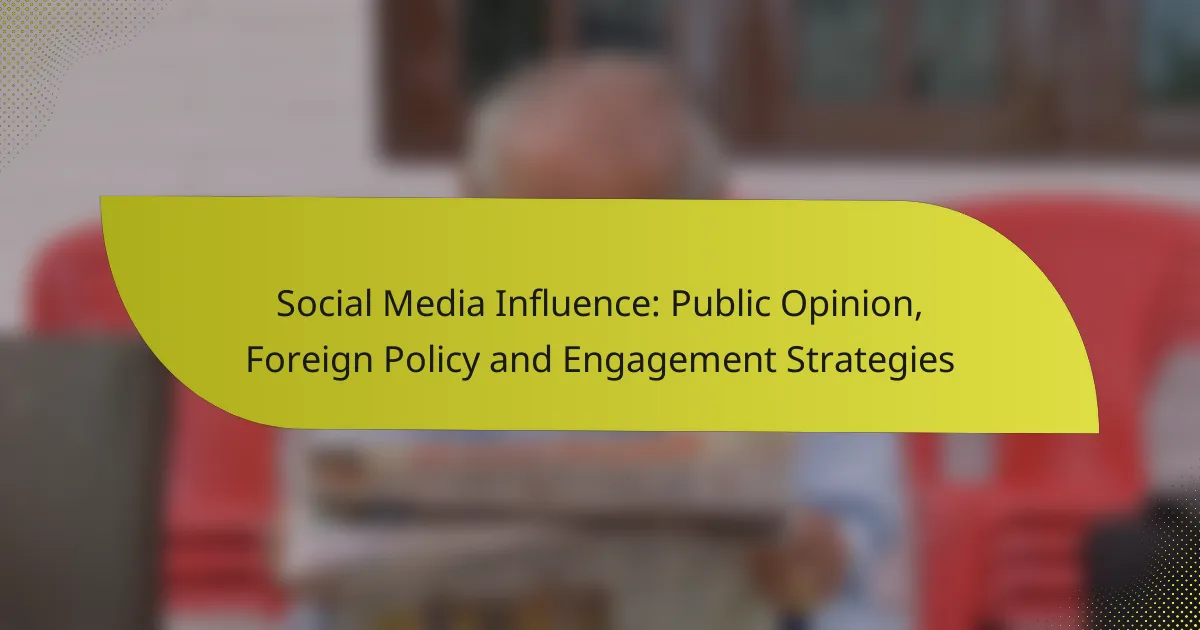Social media plays a crucial role in shaping public opinion and influencing political outcomes by enabling rapid information sharing and engagement among users. As governments adapt their foreign policy communication strategies, they increasingly leverage modern platforms and influencers to connect with diverse audiences and enhance the effectiveness of their messaging. Additionally, analytical tools allow for the measurement of public sentiment, providing valuable insights into how policies are perceived in the digital landscape.

How does social media influence public opinion in the United States?
Social media significantly shapes public opinion in the United States by providing platforms for rapid information dissemination and engagement. It allows individuals to share their views and mobilize support for various issues, ultimately influencing political outcomes and societal norms.
Impact of Twitter on political discourse
Twitter plays a crucial role in political discourse by enabling real-time communication between politicians, media, and the public. Its character limit encourages concise messaging, which can amplify key points and create viral trends that sway public sentiment.
Politicians often use Twitter to directly address constituents, bypassing traditional media filters. This direct engagement can foster a sense of connection but may also lead to the spread of misinformation if not carefully managed.
Facebook’s role in shaping voter perceptions
Facebook influences voter perceptions through targeted advertising and personalized content, allowing political campaigns to reach specific demographics effectively. This platform’s algorithms prioritize engaging content, which can skew users’ views based on what they see most frequently.
Moreover, Facebook groups and pages serve as community hubs where users can discuss political issues, further shaping opinions. However, the echo chamber effect can reinforce existing beliefs, making it essential for users to seek diverse perspectives.
Instagram’s effect on youth engagement
Instagram significantly impacts youth engagement by using visual storytelling to convey political messages. Its emphasis on imagery and short videos resonates with younger audiences, making political content more relatable and shareable.
Campaigns that leverage influencers on Instagram can effectively mobilize young voters, as these figures often have strong credibility among their followers. Engaging content, such as polls and interactive stories, can further enhance participation and awareness among youth.

What engagement strategies can enhance foreign policy communication?
Engagement strategies that enhance foreign policy communication focus on connecting with diverse audiences through modern platforms and methods. Utilizing influencers and live-streaming can significantly improve the reach and effectiveness of diplomatic messaging.
Utilizing influencers for diplomatic messaging
Influencers can play a pivotal role in shaping public opinion and facilitating dialogue around foreign policy issues. By partnering with individuals who have established credibility and a strong following, governments can amplify their messages and reach target demographics more effectively.
When selecting influencers, consider their audience demographics and engagement levels. Aim for those who align with the values and goals of the foreign policy initiative. For example, a campaign promoting climate action might collaborate with environmental activists who resonate with younger audiences.
Leveraging live-streaming for real-time updates
Live-streaming offers a dynamic way to communicate foreign policy updates directly to the public. This method fosters transparency and allows for immediate interaction, enabling viewers to ask questions and engage with officials in real-time.
To maximize the impact of live-streaming, ensure the content is accessible and engaging. Use platforms popular in the target region, such as Facebook Live or Instagram, and consider scheduling streams at times that accommodate your audience’s availability. Providing a brief summary or key takeaways after the stream can also enhance understanding and retention.

How can governments measure social media sentiment?
Governments can measure social media sentiment through various analytical tools and techniques that assess public opinion expressed online. These methods often involve tracking keywords, analyzing engagement metrics, and interpreting user-generated content to gauge overall sentiment towards policies or events.
Sentiment analysis tools like Brandwatch
Sentiment analysis tools, such as Brandwatch, utilize algorithms to evaluate social media posts and comments for positive, negative, or neutral sentiment. These platforms can analyze vast amounts of data in real-time, providing insights into public opinion trends and reactions to specific issues or events.
When using tools like Brandwatch, governments should consider the context of the data, as sentiment can vary significantly based on current events or cultural factors. Additionally, combining quantitative data with qualitative insights from user comments can enhance understanding.
Case studies on public feedback tracking
Case studies demonstrate the effectiveness of public feedback tracking in shaping government responses. For instance, during a public health crisis, governments have successfully monitored social media sentiment to adjust communication strategies and address public concerns promptly.
Another example is the use of sentiment analysis in political campaigns, where candidates track voter sentiment to tailor their messaging. These case studies highlight the importance of timely and accurate sentiment measurement in informing policy decisions and engagement strategies.
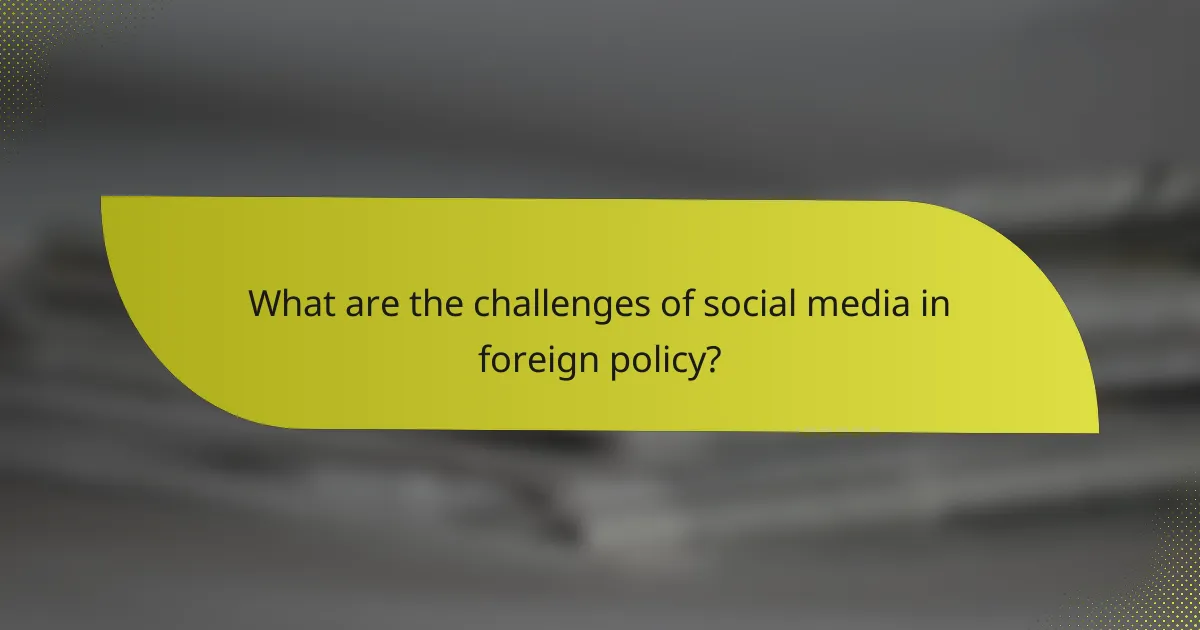
What are the challenges of social media in foreign policy?
Social media presents significant challenges in foreign policy, primarily due to the rapid dissemination of information and the potential for misinformation. Policymakers must navigate these complexities to effectively engage with the public and international stakeholders.
Information overload and misinformation
Information overload occurs when users are bombarded with excessive data, making it difficult to discern credible sources. This can lead to the spread of misinformation, where false or misleading content is shared widely, often faster than accurate information.
To combat misinformation, foreign policy experts should prioritize clear communication and fact-checking. Engaging with trusted media outlets and utilizing official channels can help ensure that accurate information reaches the public. Regular monitoring of social media trends is essential to identify and address misinformation promptly.
Balancing transparency and security
Balancing transparency and security is crucial in foreign policy communication. While transparency fosters trust and public engagement, revealing too much information can jeopardize national security and diplomatic relations.
Policymakers should adopt a strategic approach by sharing relevant information that promotes accountability while safeguarding sensitive details. Establishing guidelines for what information can be disclosed and training officials on social media best practices can help maintain this balance effectively.
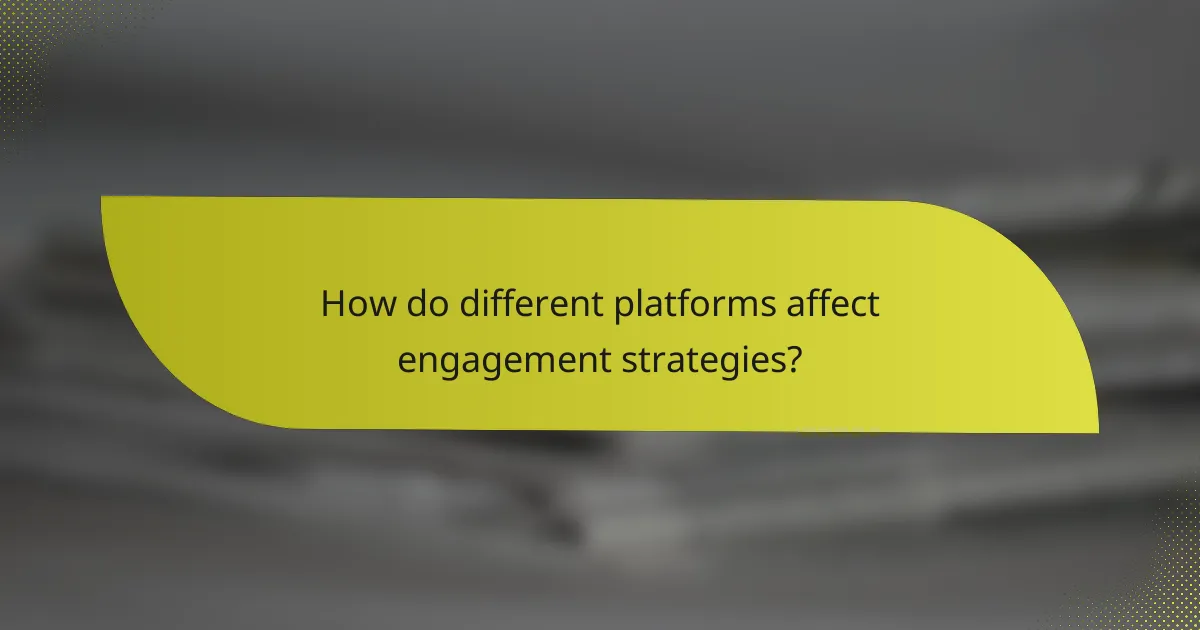
How do different platforms affect engagement strategies?
Different social media platforms shape engagement strategies by influencing how quickly and effectively messages reach audiences. Each platform has unique characteristics that dictate the best approaches for communication, community building, and professional interactions.
Twitter for rapid response communication
Twitter is ideal for rapid response communication due to its real-time nature and character limit, which encourages concise messaging. Organizations can quickly address public concerns, share updates, or respond to crises within minutes, making it a powerful tool for immediate engagement.
To leverage Twitter effectively, focus on timely posts, use relevant hashtags, and engage with followers through retweets and replies. Avoid lengthy explanations; instead, aim for clarity and brevity to capture attention quickly.
Facebook for community building
Facebook excels at community building, allowing organizations to create groups and pages that foster interaction among members. This platform encourages deeper connections through longer posts, multimedia content, and discussions, making it suitable for nurturing relationships and engaging audiences over time.
To maximize Facebook’s potential, regularly post engaging content, encourage user participation through polls or questions, and respond to comments promptly. Consider hosting live events or Q&A sessions to further enhance community interaction.
LinkedIn for professional diplomacy
LinkedIn is the premier platform for professional diplomacy, allowing organizations to connect with industry leaders, policymakers, and potential partners. It facilitates networking and showcases expertise through articles, posts, and professional achievements.
For effective engagement on LinkedIn, share insightful content relevant to your industry, participate in discussions within professional groups, and connect with key influencers. Maintain a professional tone and focus on building long-term relationships rather than immediate gains.
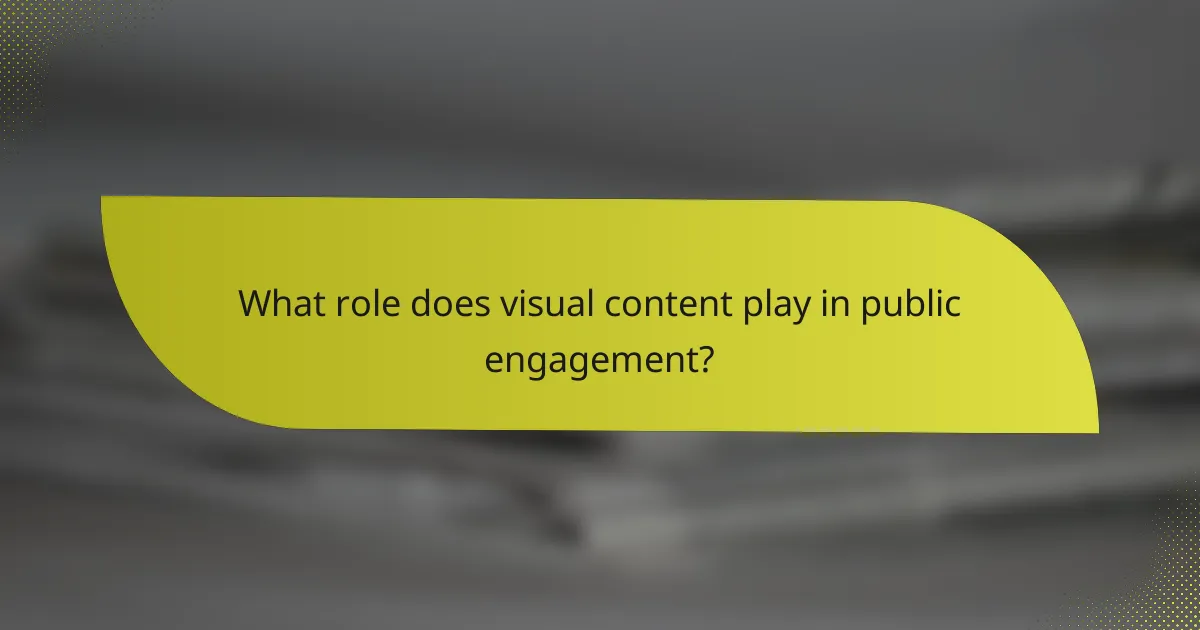
What role does visual content play in public engagement?
Visual content significantly enhances public engagement by making information more accessible and appealing. It simplifies complex topics, captures attention quickly, and fosters emotional connections, which are essential for effective communication in social media and public discourse.
Infographics for simplifying complex policies
Infographics serve as powerful tools for breaking down intricate policies into digestible visuals. They combine text, images, and data to convey information quickly, making it easier for audiences to grasp key points without overwhelming details.
When creating infographics, focus on clarity and relevance. Use a clean layout, limit text, and highlight essential data points. For instance, a visual representation of a new healthcare policy can illustrate its benefits and costs in a straightforward manner, appealing to a broader audience.
Videos for emotional storytelling
Videos are effective for emotional storytelling, allowing organizations to connect with audiences on a personal level. They can convey narratives that resonate, making complex issues relatable and prompting viewers to engage or take action.
To maximize impact, keep videos concise, ideally under two minutes, and focus on a single message or story. Incorporate personal testimonials or real-life examples to enhance relatability. For example, a short video highlighting the experiences of individuals affected by a foreign policy can evoke empathy and drive public interest.
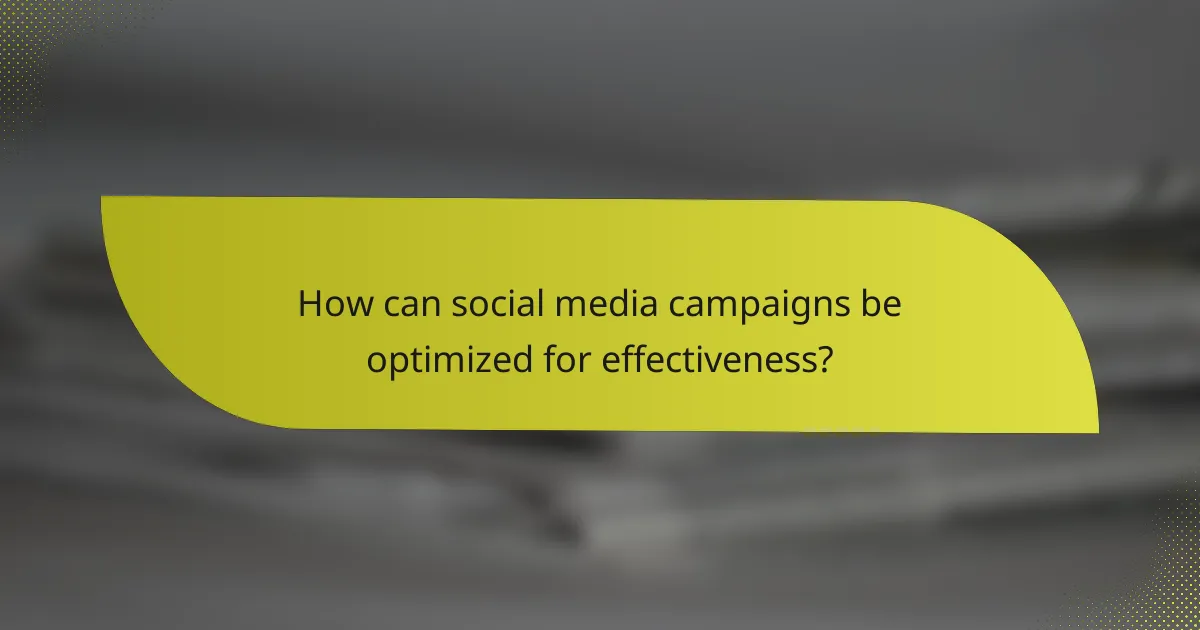
How can social media campaigns be optimized for effectiveness?
To optimize social media campaigns for effectiveness, focus on clear objectives, audience understanding, and data-driven strategies. This involves tailoring content to resonate with specific demographics and continuously refining approaches based on performance metrics.
Target audience segmentation techniques
Effective audience segmentation involves dividing your target market into distinct groups based on characteristics such as demographics, interests, and online behavior. This allows for more personalized messaging that can significantly enhance engagement rates.
Consider using tools like Facebook Insights or Google Analytics to gather data on your audience. For example, segmenting by age groups can help tailor content that speaks directly to the interests of millennials versus baby boomers.
A/B testing for content performance
A/B testing is a powerful method for comparing two versions of content to determine which performs better. By changing one variable, such as the headline or image, you can gather insights on what resonates more with your audience.
Implement A/B tests on social media ads or posts, and aim for a sample size that provides statistically significant results. For instance, testing two different call-to-action phrases can reveal which prompts more clicks or shares, guiding future content strategies.
